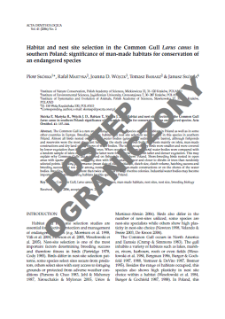
Object
Title: Habitat and nest site selection in the Common Gull Larus canus in southern Poland: significance of man-made habitats for conservation of an endangered species
Creator:
Skórka, Piotr ; Martyka, Rafał ; Wójcik, Joanna D ; Babiarz, Tomasz ; Skórka, Janusz
Date issued/created:
Resource type:
Subtitle:
Contributor:
Museum and Institute of Zoology, Polish Academy of Sciences
Publisher:
Museum and Institute of Zoology, Polish Academy of Sciences
Place of publishing:
Description:
Type of object:
Abstract:
The Common Gull is a rare and endangered breeding species at inland habitats in Poland as well as in some other countries in Europe. Breeding biology, habitat and nest site selection were studied in this species in southern Poland. Almost all birds nested on industrial water bodies (gravel pits, sedimentation basins), although fishponds and reservoirs were the most abundant habitat in the study area. Birds built their nests mainly on islets, man-made constructions and dry land on the shores of water bodies. The islets occupied by birds were smaller and were covered by lower vegetation than the unoccupied ones. When occupied islets on industrial water bodies were compared with a random sample of islets on fishponds, the latter were found to be larger, with taller and denser vegetation. This may explain why Common Gulls did not breed on fishponds in southern Poland. Shore-breeding birds nested in open areas with sparse vegetation, occupying sites with less vegetation cover and closer to shrubs or trees than randomly selected points. Breeding performance (mean date of clutch initiation, clutch size, clutch volume, hatching success and breeding success) did not differ among nests built on islets, man-made constructions or on the shores of the water bodies. Breeding success was more than twice as high as in large riverine colonies. Industrial water bodies may become important alternative breeding habitats for this species in Poland.
Relation:
Volume:
Issue:
Start page:
End page:
Detailed Resource Type:
Format:
Resource Identifier:
Source:
MiIZ PAN, sygn. P.4568 ; MiIZ PAN, sygn. P.257 ; click here to follow the link
Language:
Language of abstract:
Rights:
Prawa zastrzeżone - dostęp ograniczony
Terms of use:
Original in:
Biblioteka Muzeum i Instytutu Zoologii PAN
Access:
Object collections:
- Digital Repository of Scientific Institutes > Partners' collections > Museum and Institute of Zoology PAS > Scientific Journals
- Digital Repository of Scientific Institutes > Partners' collections > Museum and Institute of Zoology PAS > MIZ PAN Publications > Acta Ornithologica
- Digital Repository of Scientific Institutes > Literature > Journals/Articles
Last modified:
Oct 2, 2020
In our library since:
Jun 15, 2018
Number of object content downloads / hits:
50
All available object's versions:
https://rcin.org.pl/publication/75760
Show description in RDF format:
Show description in RDFa format:
Show description in OAI-PMH format:
Objects Similar
Skórka, Piotr Martyka, Rafał Wójcik, Joanna D
Kosiński, Ziemowit
Lu, Xin
Alabrudzińska, Jagna Kaliński, Adam Słomczyński, Robert Wawrzyniak, Jarosław Zieliński, Piotr Bańbura, Jerzy
Kędra, Aleksander H. Mazgajski, Tomasz D. Kowalczyk, Krzysztof
Murgui, Enrique
Antonov, Anton (1977–2012) Atanasova, Dimitrinka
Gokula, Varadhrajan

 INSTYTUT ARCHEOLOGII I ETNOLOGII POLSKIEJ AKADEMII NAUK
INSTYTUT ARCHEOLOGII I ETNOLOGII POLSKIEJ AKADEMII NAUK
 INSTYTUT BADAŃ LITERACKICH POLSKIEJ AKADEMII NAUK
INSTYTUT BADAŃ LITERACKICH POLSKIEJ AKADEMII NAUK
 INSTYTUT BADAWCZY LEŚNICTWA
INSTYTUT BADAWCZY LEŚNICTWA
 INSTYTUT BIOLOGII DOŚWIADCZALNEJ IM. MARCELEGO NENCKIEGO POLSKIEJ AKADEMII NAUK
INSTYTUT BIOLOGII DOŚWIADCZALNEJ IM. MARCELEGO NENCKIEGO POLSKIEJ AKADEMII NAUK
 INSTYTUT BIOLOGII SSAKÓW POLSKIEJ AKADEMII NAUK
INSTYTUT BIOLOGII SSAKÓW POLSKIEJ AKADEMII NAUK
 INSTYTUT CHEMII FIZYCZNEJ PAN
INSTYTUT CHEMII FIZYCZNEJ PAN
 INSTYTUT CHEMII ORGANICZNEJ PAN
INSTYTUT CHEMII ORGANICZNEJ PAN
 INSTYTUT FILOZOFII I SOCJOLOGII PAN
INSTYTUT FILOZOFII I SOCJOLOGII PAN
 INSTYTUT GEOGRAFII I PRZESTRZENNEGO ZAGOSPODAROWANIA PAN
INSTYTUT GEOGRAFII I PRZESTRZENNEGO ZAGOSPODAROWANIA PAN
 INSTYTUT HISTORII im. TADEUSZA MANTEUFFLA POLSKIEJ AKADEMII NAUK
INSTYTUT HISTORII im. TADEUSZA MANTEUFFLA POLSKIEJ AKADEMII NAUK
 INSTYTUT JĘZYKA POLSKIEGO POLSKIEJ AKADEMII NAUK
INSTYTUT JĘZYKA POLSKIEGO POLSKIEJ AKADEMII NAUK
 INSTYTUT MATEMATYCZNY PAN
INSTYTUT MATEMATYCZNY PAN
 INSTYTUT MEDYCYNY DOŚWIADCZALNEJ I KLINICZNEJ IM.MIROSŁAWA MOSSAKOWSKIEGO POLSKIEJ AKADEMII NAUK
INSTYTUT MEDYCYNY DOŚWIADCZALNEJ I KLINICZNEJ IM.MIROSŁAWA MOSSAKOWSKIEGO POLSKIEJ AKADEMII NAUK
 INSTYTUT PODSTAWOWYCH PROBLEMÓW TECHNIKI PAN
INSTYTUT PODSTAWOWYCH PROBLEMÓW TECHNIKI PAN
 INSTYTUT SLAWISTYKI PAN
INSTYTUT SLAWISTYKI PAN
 SIEĆ BADAWCZA ŁUKASIEWICZ - INSTYTUT TECHNOLOGII MATERIAŁÓW ELEKTRONICZNYCH
SIEĆ BADAWCZA ŁUKASIEWICZ - INSTYTUT TECHNOLOGII MATERIAŁÓW ELEKTRONICZNYCH
 MUZEUM I INSTYTUT ZOOLOGII POLSKIEJ AKADEMII NAUK
MUZEUM I INSTYTUT ZOOLOGII POLSKIEJ AKADEMII NAUK
 INSTYTUT BADAŃ SYSTEMOWYCH PAN
INSTYTUT BADAŃ SYSTEMOWYCH PAN
 INSTYTUT BOTANIKI IM. WŁADYSŁAWA SZAFERA POLSKIEJ AKADEMII NAUK
INSTYTUT BOTANIKI IM. WŁADYSŁAWA SZAFERA POLSKIEJ AKADEMII NAUK


































